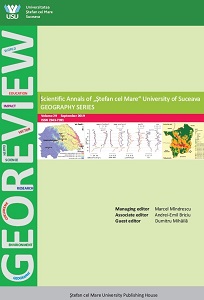The risk of disappearance of amphibians and reptiles in the Lower Prut Area in the context of climate change
The risk of disappearance of amphibians and reptiles in the Lower Prut Area in the context of climate change
Author(s): Adam BeguSubject(s): Regional Geography, Environmental Geography, Human Ecology, Environmental interactions
Published by: UNIVERSITATEA »ȘTEFAN CEL MARE« SUCEAVA
Keywords: amphibians; reptiles; Lower Prut; climate change;
Summary/Abstract: Amphibians and reptiles are among the most endangered organisms worldwide - respectively about 35% and 20% (IUCN, 2022). Their vulnerability is related to the insufficiency of ecologically optimal habitats (climatic, physico-chemical, biocenotic) for development and reproduction. The 9 species of amphibians and 7 reptiles from in the Lower Prut Area, present important ecological links in the ecosystems specific to the given area, and 5 and 3 species, respectively, are included in the Red Book of the Republic of Moldova (2015). Thus, Pelobates fuscus is Critically Endangered (CR), and pollution, and especially the drying up of lakes, would lead to the extinction of the species. The vulnerable species (VU) of Triturus cristatus and Lissotriton vulgaris will be quite affected, both by desiccation and by the lack of oxygen during the summer period. The species Bombina bombina, Hyla orientalis, Pelophylax ridibundus,Pelophylax lessonae and Bufo viridis have a wider ecological valence, which makes them less threatened by climate change, but remain linked to waters for reproduction. Reptiles prefer shady, moist, swampy, aquatic habitats, etc., but they also need sufficiently sunny places. The 3 endangered species (EN), such as Emys orbicularis, although it is omnivorous, is very rarely encountered (RR); the species of Podarcis taurica, Coluber caspius, Lacerta agilis, Lacerta viridis have a wider ecological valence and show a weak vulnerability to climate change, and the dependence on food resources of the Natrix natrix and Natrix tessellate makes them more vulnerable to the drying up of water bodies. In order to reduce the negative effects of climate change on vulnerable amphibians and reptiles, scientifically substantiated interventions are needed to rebuild habitats, to form ecological corridors connecting certain fragmented isoecohabitats, to expand the areas occupied by threatened species in various sectors, both with optimal conditions, as well as at the limit of extremes.
Journal: GEOREVIEW
- Issue Year: 33/2023
- Issue No: 1
- Page Range: 61-69
- Page Count: 9
- Language: English

